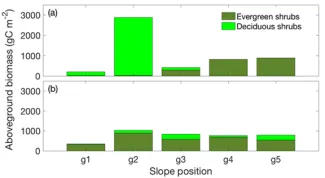Scientists on the NGEE Arctic project find that topography and landscape hydrology are key environmental controls on observed Arctic shrub expansion of the past three decades.
Observations indicate shrubs are expanding across the Arctic tundra, mainly on hillslopes and primarily in response to climate warming. However, the impact topography exerts on hydrology, nutrient dynamics, and plant growth can make untangling the mechanisms behind shrub expansion difficult. Researchers examined the role topography plays in determining shrub expansion by applying a coupled transect version of a mechanistic ecosystem model (ecosys) in a tundra hillslope site in the Seward Peninsula, Alaska (Mekonnen et al., 2021a). Modeled biomass of the dominant plant functional types agreed well with field measurements (R2 = 0.89) and accurately represented shrub expansion over the past 30 years inferred from satellite observations. In the well-drained crest position, canopy water potential and plant N uptake was modeled to be low from plant and microbial water stress. Intermediate soil water content in the mid-slope position enhanced mineralization and plant N uptake, increasing shrub biomass. The deciduous shrub growth in the mid-slope position was further enhanced by symbiotic N2 fixation primed by increased root carbon allocation. The gentle slope in the poorly-drained lower-slope position resulted in saturated soil conditions that reduced soil O2 concentrations, leading to lower root O2 uptake and lower nutrient uptake and plant biomass. A simulation that removed topographical inter-connectivity between grid cells resulted in (1) a 28% underestimate of mean shrub biomass and (2) over- or under-estimated shrub productivity at the various hillslope positions. These results indicate that land models need to account for hillslope-scale coupled surface and sub-surface hydrology to accurately predict current plant distributions and future trajectories in Arctic ecosystems.
Citation: Mekonnen, Z. A., W. J. Riley, R. F. Grant, V. G. Salmon, C. M. Iversen, S. C. Biraud, A. L. Breen, and M. J. Lara. 2021b. “Topographical Controls on Hillslope-Scale Hydrology Drive Shrub Distributions on the Seward Peninsula, Alaska.” JGR-Biogeosciences 126: e2020JG005823. https://doi.org/10.1029/2020JG005823.


